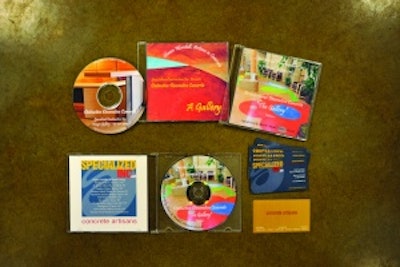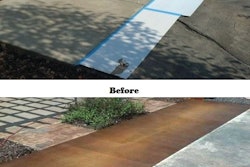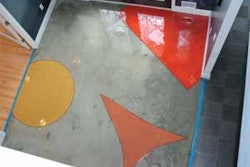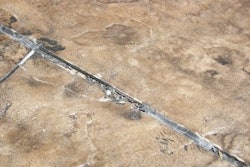
It seems like I have spent a lifetime in the construction industry. I was fortunate enough to have an uncle in the business who allowed me to start at the ripe age of 12. Minimum wage at that time was $1.90 an hour, and I thought it was cool to be making a starting wage of $2.00 an hour.
I continued to work every summer, then through college, then to the corporate world of big, union commercial construction. It was during that time, while managing a large hospital expansion, I had to estimate some stained concrete as part of our work package. I had never heard of stained concrete and consulted with a colleague in our office who agreed I would be covered if I plugged a buck a foot in for the staining. That day the decorative concrete bug bit me, and now decorative concrete is all I do.
Today, like 12 years ago when I was first exposed to decorative concrete, I find that many people don't know the many possibilities that are available with decorative concrete. We as trade specialized professionals need to take every opportunity to educate people about decorative concrete. And when it comes to a marketing strategy you will need to customize it to your client's needs and education level in regards to decorative concrete.
A visual impression
So how does one go about getting a steady, meaningful flow of decorative concrete work? Place your ad in the phone book? Make your truck a billboard? Buy a listing on a Web service? Become a member of a builders association? Place signs at current projects? These traditional methods all have their pros and cons. They may work well for you if you can use them to separate yourself from your competition. In today's market, you have to have a better mouse trap and be sure your potential client knows you have it! This is where you may want to consider more visual marketing techniques.
A good quality website is a must, and should be customized to help set yourself apart from your competition. Another key aspect that goes with this is your logo. This is what sets up your brand and begins to separate you from the crowd. I had a hard time justifying this added expense as a small business, but after viewing the first proof sheet from my designer, the logo was clearly worth the expense. The logo lays the groundwork for the website design, business cards and letterhead. As a concrete guy, I wasn't sure about this branding thing, but I sure appreciate hearing people tell me how cool my business cards and website are. Selecting the right professional to establish your brand is money well spent - don't cheat yourself on this one!
You're going to need a collection of your best photos to fill that website as well as your portfolio. As decorative concrete is an extremely visual medium, exceptional photographs are critical. This is where prospective clients will short list or cut you from consideration rather quickly. From my experience, I find it best to take our own photos when possible. It would be difficult to schedule, let alone expensive to hire, a professional photographer for all our projects.
In my early years I would take hundreds of pictures of our work hoping for a couple of good shots. Shooting lots of progress photos will help you find the best angles for shooting your finished work. Spend time studying photos in magazines for ways to capture your work, or even consider a class or workshop on photography. When your project is complete and you're ready for the prize shots, remember to set your camera to the highest resolution. Lower resolution photos will not be crisp and in focus when blown up for your portfolio or shown on a computer monitor. More importantly, photos showing a clean, fully furnished area will always look better than an in progress shot with your masking tape still on the walls. Make every possible effort for great pictures, and lots of them.
Connect with Clients
Pictures are my number one sales tool. Every contractor says he's the best, fastest, and most cost effective when speaking with a prospective client. Let your work - your pictures - speak for you and set you apart from the competition. I have two portfolios I carry with me on sales calls. One book contains 200 to 300 4x6 photos that represent a very comprehensive collection of our work. The other is 30 to 40 pages of 8x10 photos of our best work and photo quality. This one helps cut to the chase quickly when you're not given much time.
The greatest marketing tool our firm has produced is a disk that plays a slide show of our work set to music. This runs between 100 and 120 photos that fade and scroll from one to another for about 5 minutes. There are intro slides with our company info over a close-up shot of some interesting detail of our work. We close with encouraging words inviting prospective clients to have their project next on our disk. We print a professional quality label for the disk and cover for the box that holds the disk. We even created a back cover highlighting the job names and locations of the projects contained on the disk. As new projects are completed, and photos become available, we can edit these in and create a new volume for the disk collection. I have experienced times where our disk alone has closed the deal.
I find it best to call on design professionals who are known to appreciate concrete. These are the people that will design your work into a project, so you will want to keep in touch with them. Creating a new volume for your CD collection is a good excuse to visit these contacts and keep your firm on their mind for upcoming projects. We will also be working toward an e-mail newsletter to be sent out three or four times a year.
Home owners are my next best contact. These are generally people who have done a lot of research and have a great appreciation for our craft. Residential can be a fun market since you're working directly with the decision maker. This is also a prime market for upselling once they learn what is possible with concrete.
Home builders catering to higher end homes are also great contacts to maintain. On the other hand, I find commercial general contractors to be much less productive. This is the low-bid market, where there are no extra credit points for artistic impression.



















